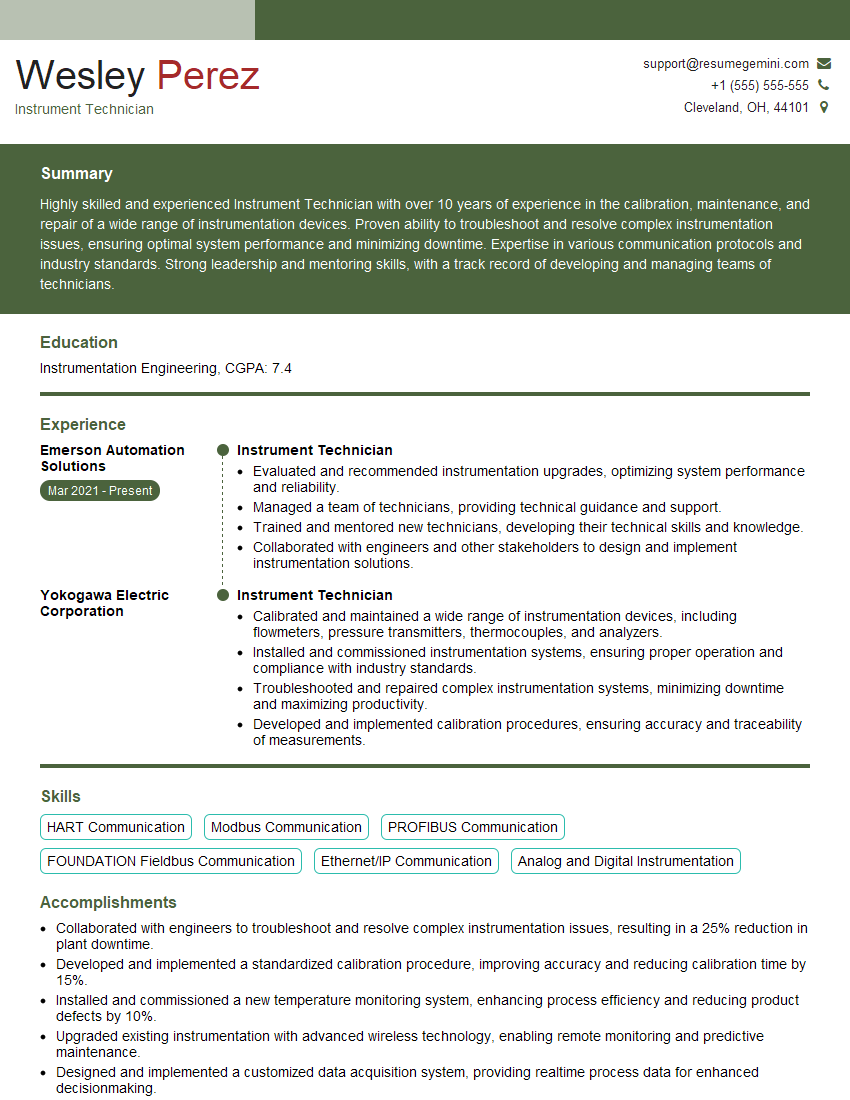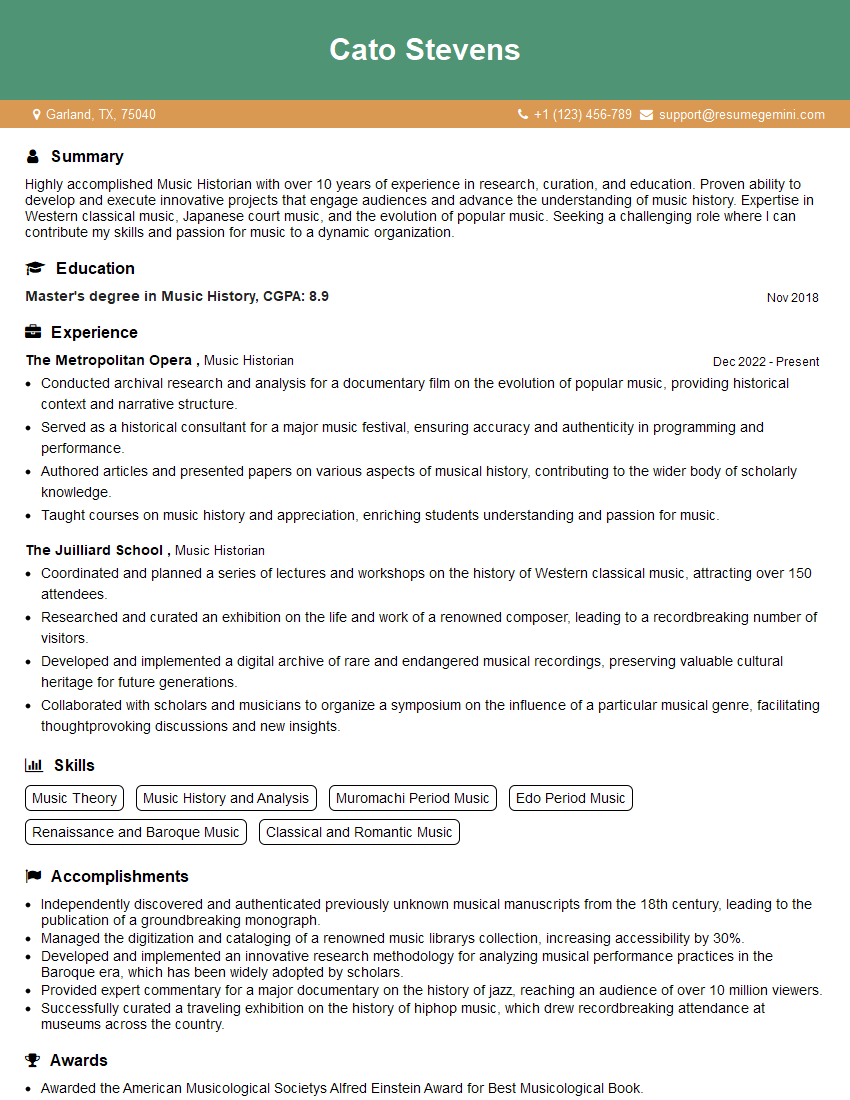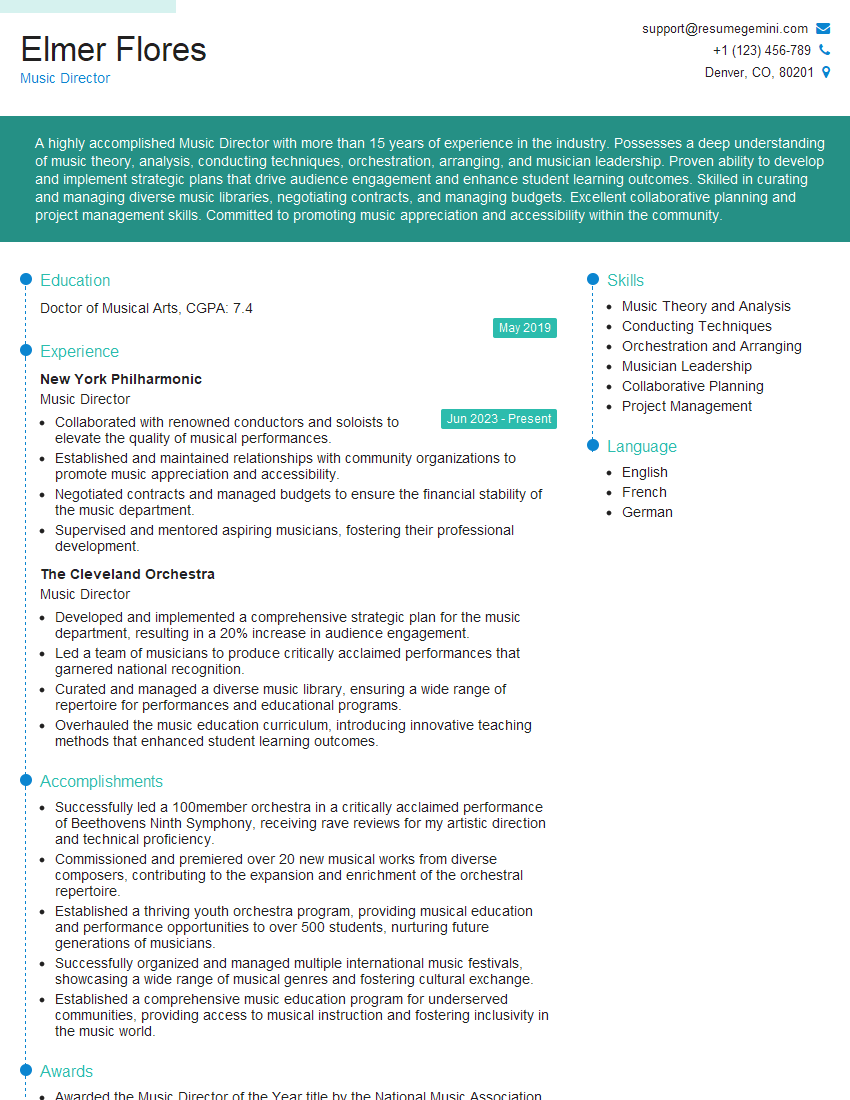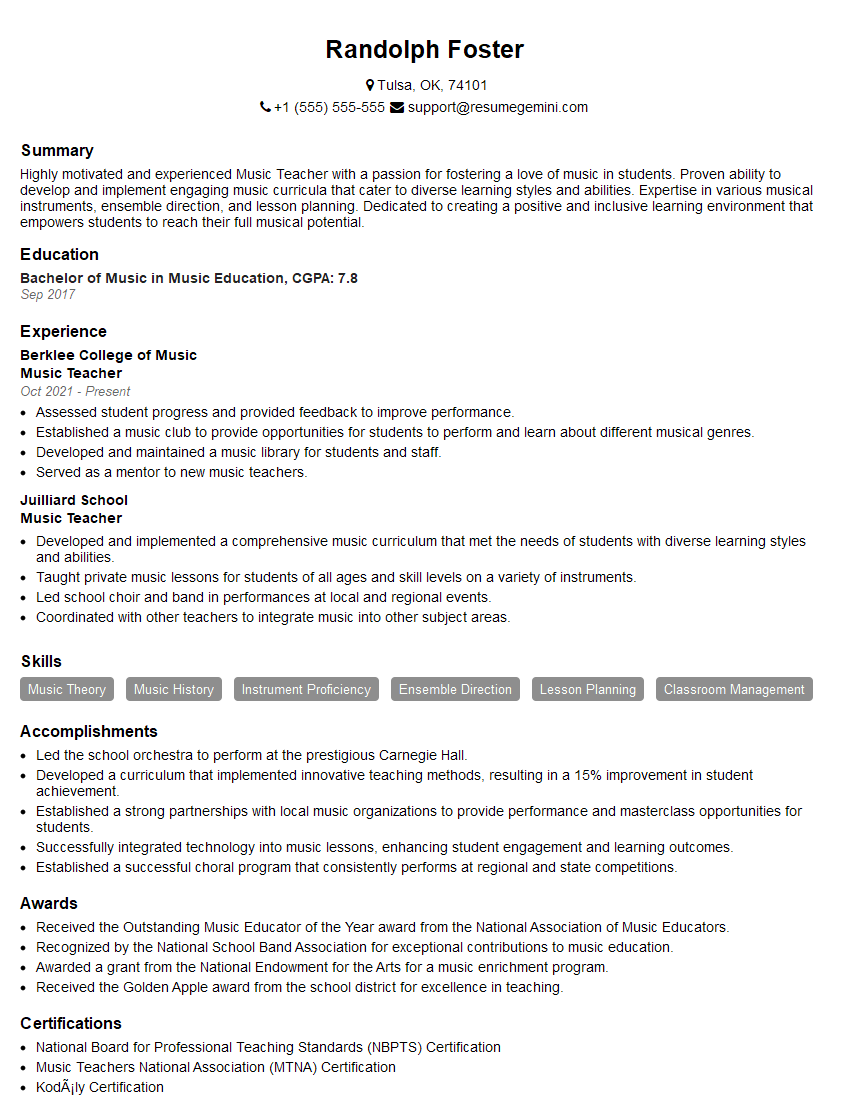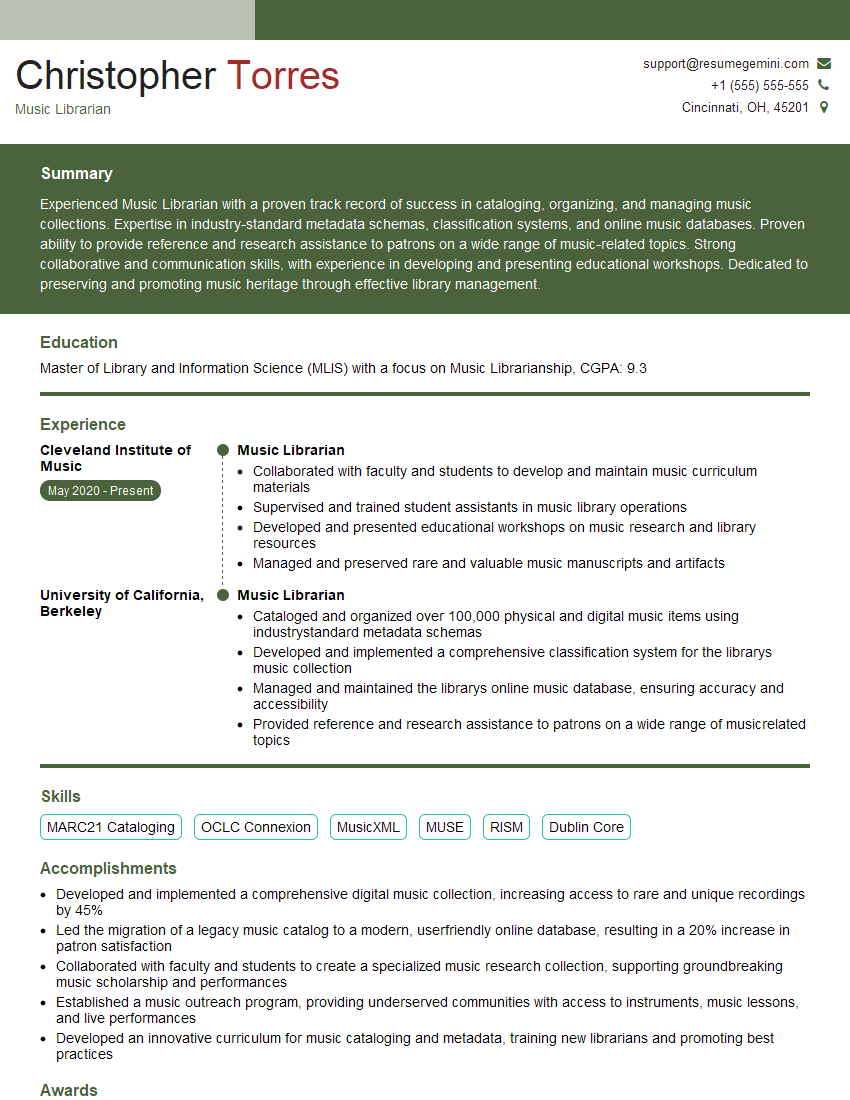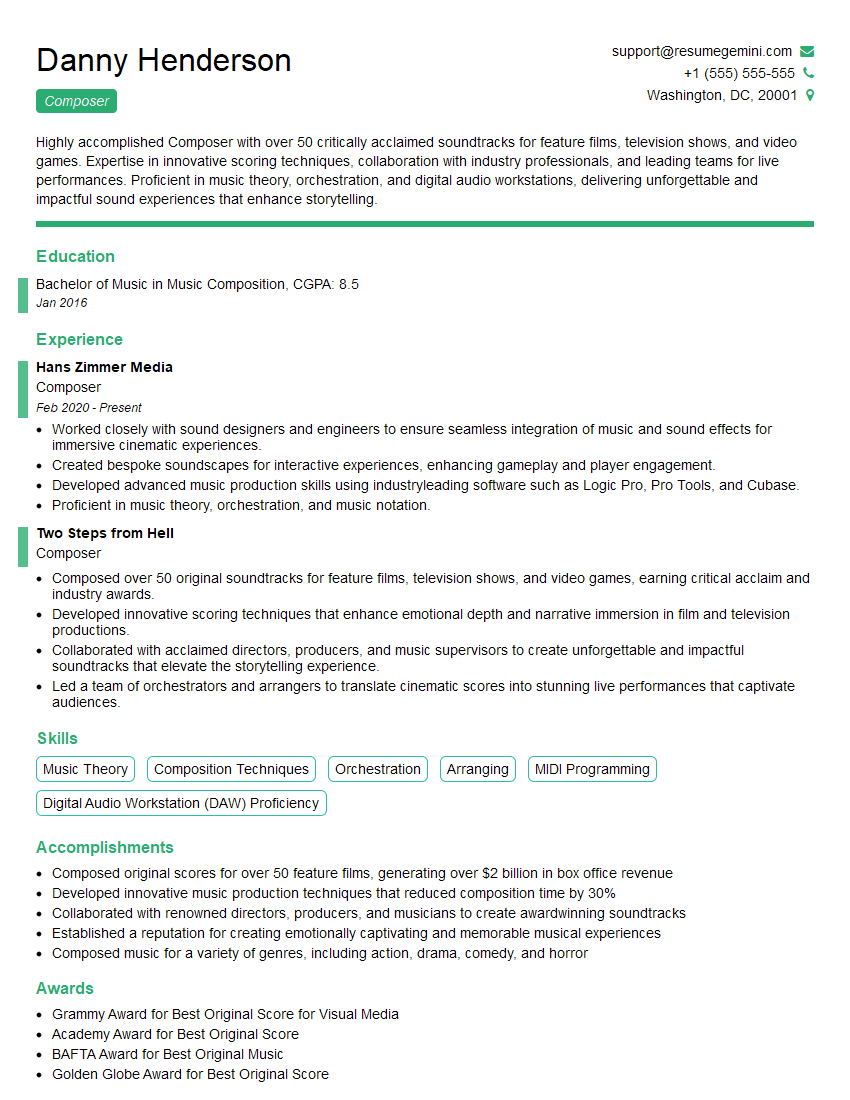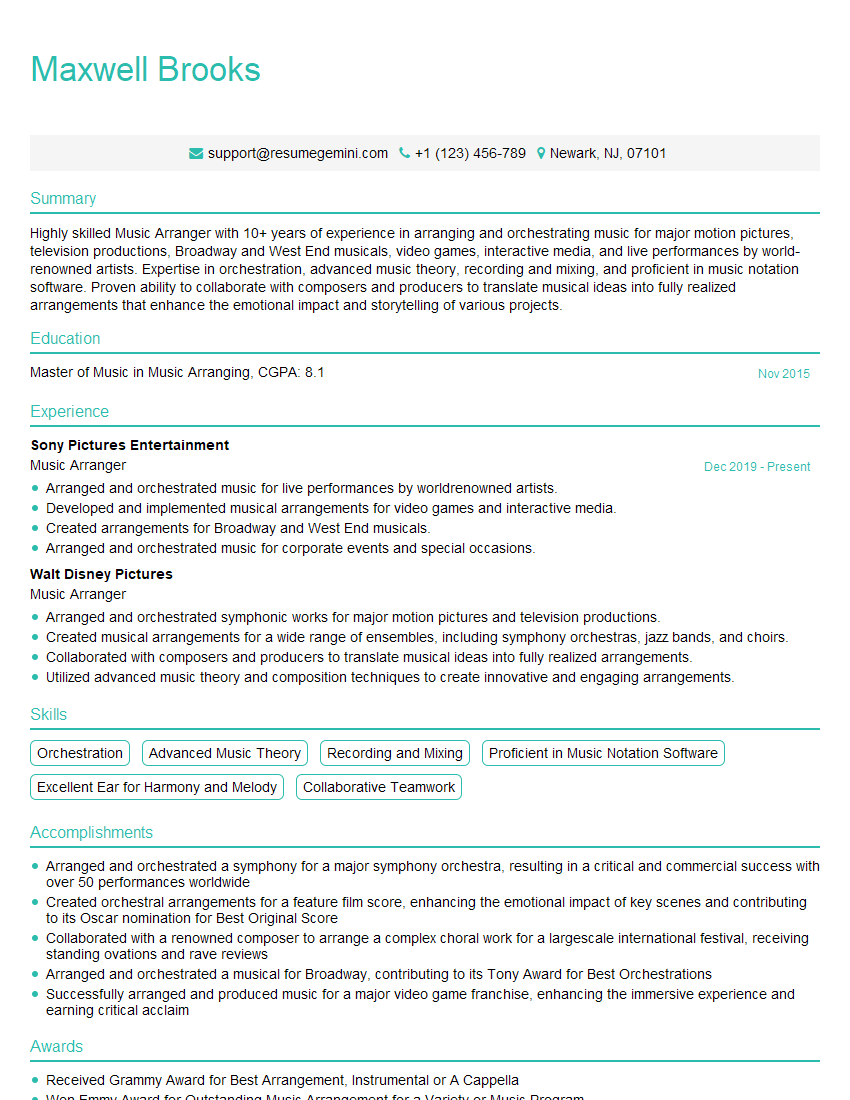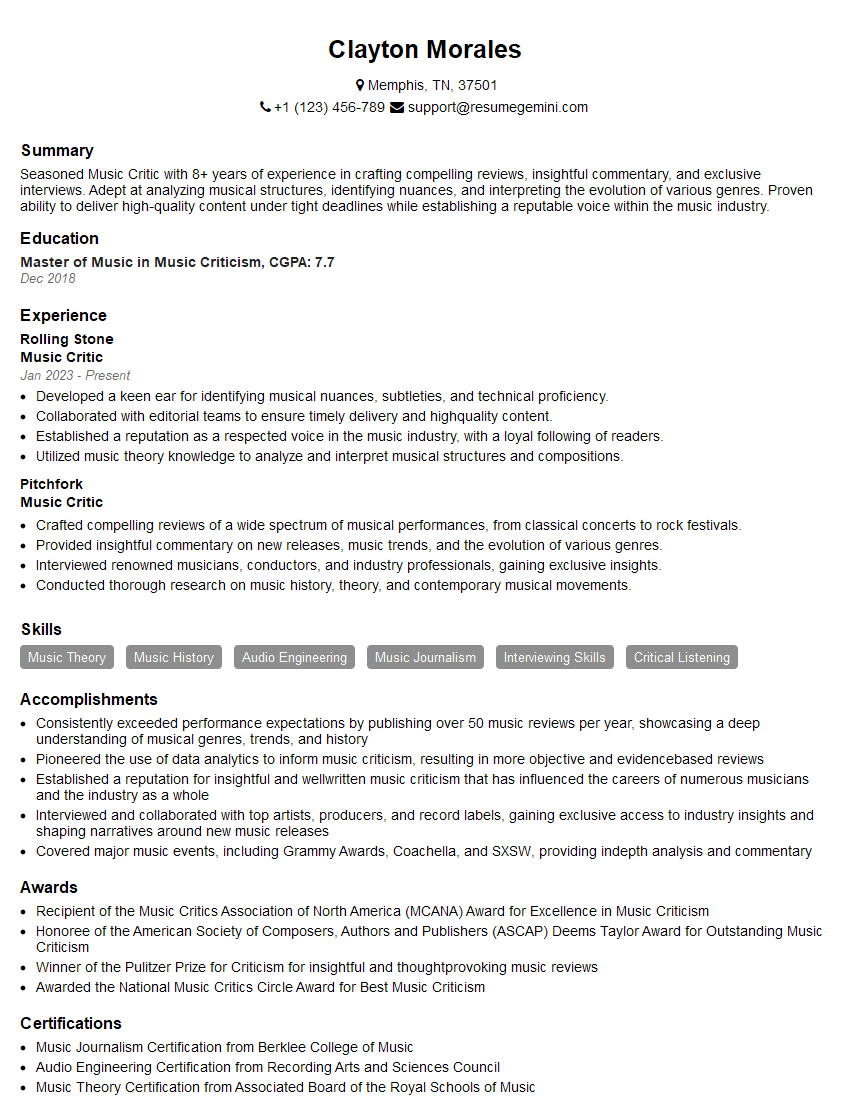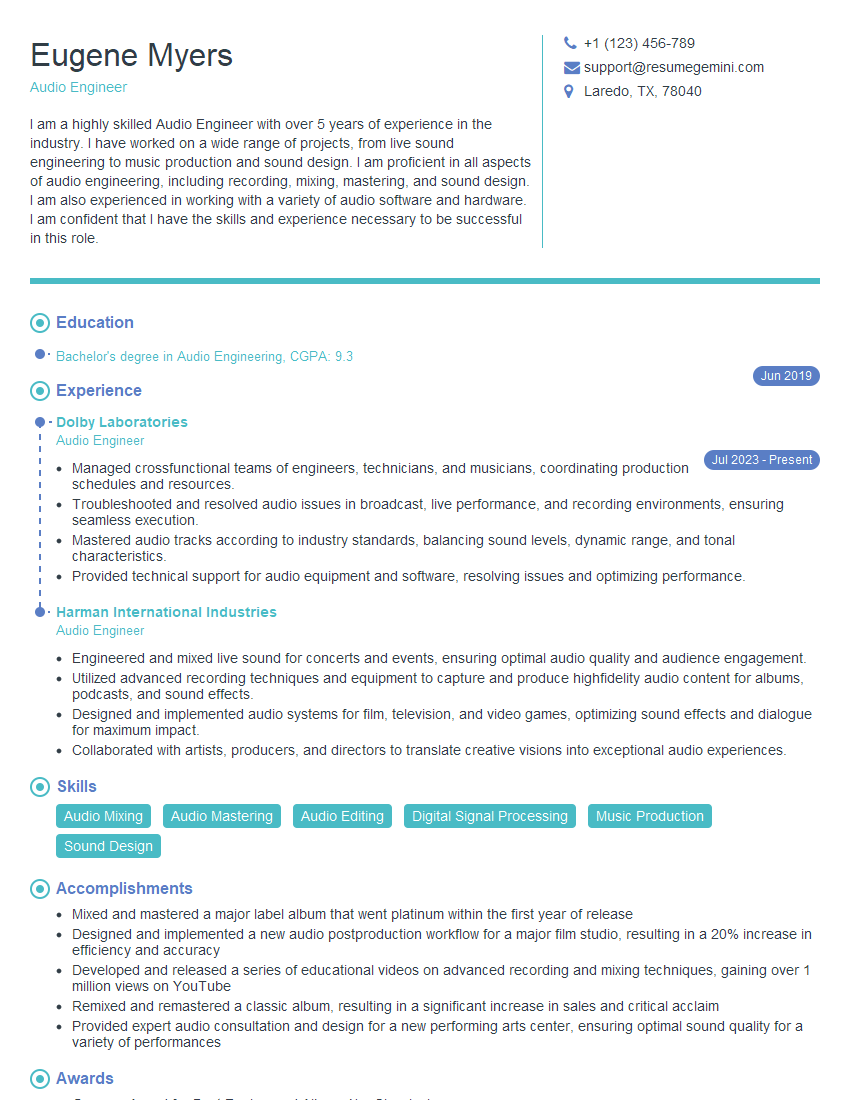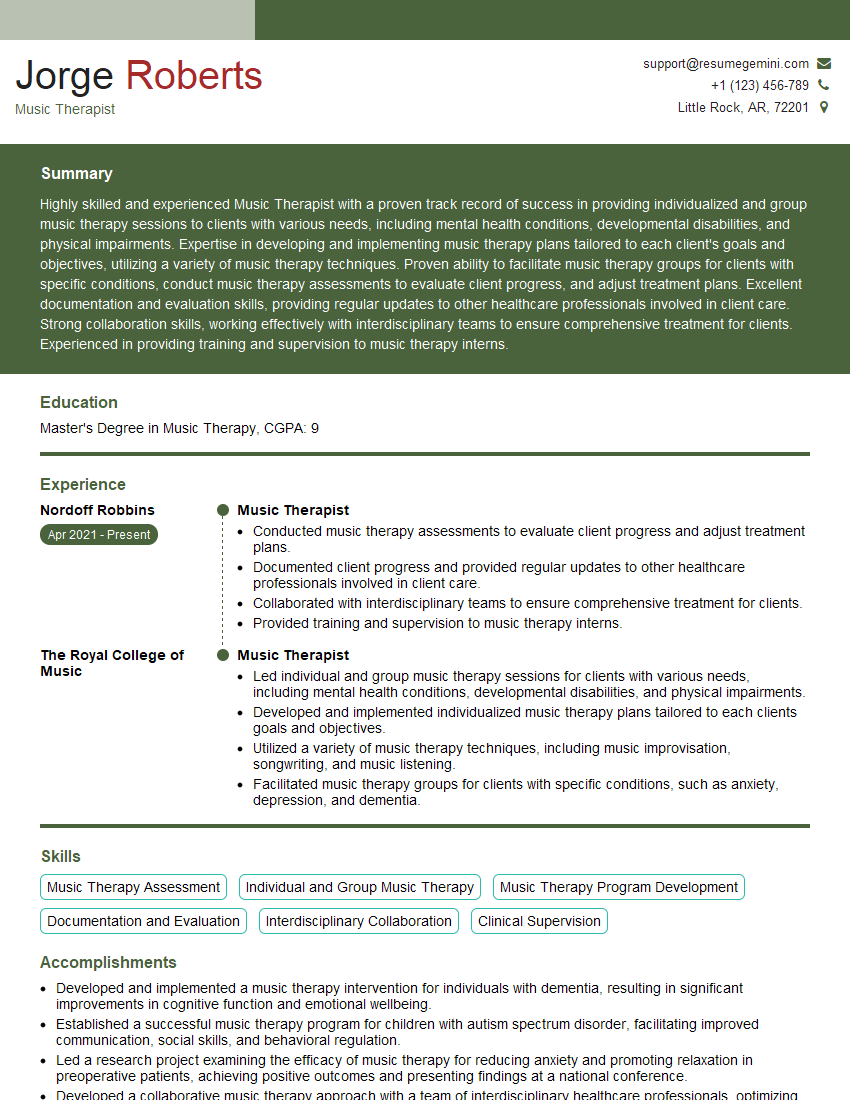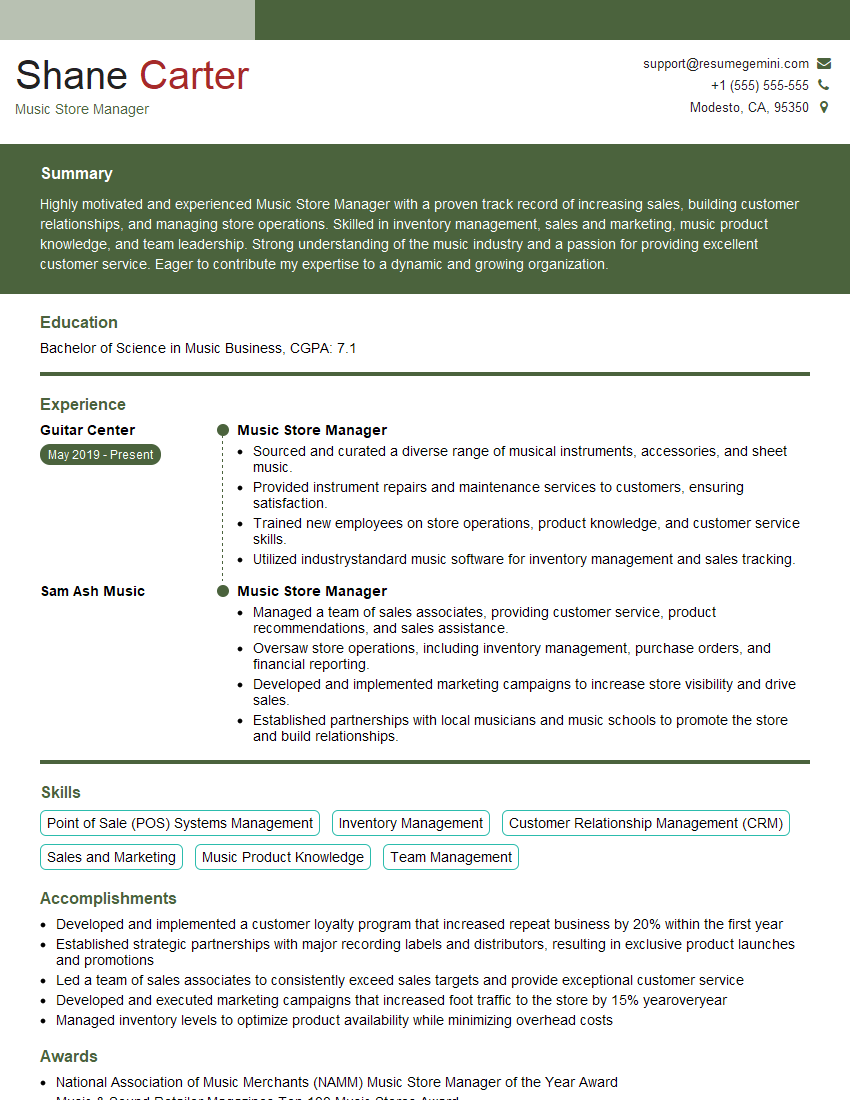Unlock your full potential by mastering the most common Understanding of musical instruments interview questions. This blog offers a deep dive into the critical topics, ensuring you’re not only prepared to answer but to excel. With these insights, you’ll approach your interview with clarity and confidence.
Questions Asked in Understanding of musical instruments Interview
Q 1. Explain the difference between a fretted and fretless instrument.
The fundamental difference between fretted and fretless instruments lies in how pitch is determined. Fretted instruments, like guitars and banjos, have metal frets positioned along the fingerboard at precise intervals. These frets physically limit the length of the vibrating string, defining specific pitches. Pressing a string down behind a fret shortens the vibrating length, producing a higher pitch. The distance between frets is carefully calculated to create the correct intervals of a musical scale.
Fretless instruments, such as the double bass and some violins, lack these frets. The player determines the pitch solely by the position of their fingers along the fingerboard. This allows for a much greater degree of expressive nuance, enabling microtonal inflections and slides between notes not possible on a fretted instrument. However, it also requires significantly greater precision and skill from the performer to achieve accurate intonation.
Think of it like this: a fretted instrument is like choosing from a set of pre-defined options, while a fretless instrument is like having a continuous spectrum of possibilities.
Q 2. Describe the various types of wood used in string instrument construction and their tonal properties.
The choice of wood in string instrument construction significantly impacts the instrument’s tonal characteristics. Different woods possess unique density, stiffness, and resonant properties that affect the sound’s timbre, projection, and responsiveness.
- Spruce: Commonly used for the soundboard (top) of violins, guitars, and pianos, spruce offers a bright, clear tone with excellent projection. Its lightweight yet strong nature allows for efficient vibration transmission.
- Maple: Often used for the back and sides of violins and guitars, maple contributes a rich, warm tone with a strong fundamental. Its denser structure provides a more focused and powerful sound.
- Rosewood: A prized wood for the back and sides of guitars, rosewood offers a warm, resonant tone with a strong fundamental. It contributes to the guitar’s sustain and projection. Brazilian rosewood, historically the most desirable, is now regulated due to its endangered status.
- Ebony: Frequently used for fingerboards, ebony is dense and hard, providing a smooth, durable playing surface with excellent resistance to wear. It also adds a slight darkness and richness to the overall sound.
The specific type of wood, its age, and even the climate it was grown in can all subtly influence the instrument’s final sound. Master luthiers meticulously select wood for its acoustic properties to achieve the desired tonal qualities.
Q 3. What are the key components of a brass instrument, and how do they affect sound production?
Brass instruments produce sound through the vibration of the player’s lips against a mouthpiece, creating standing waves within a resonating tube. Key components include:
- Mouthpiece: This is the initial point of sound production. The shape and size of the mouthpiece influence the player’s embouchure (mouth formation) and the resulting tone. Different mouthpieces offer varied resistance and flexibility.
- Leadpipe: The initial section of tubing connecting the mouthpiece to the main body, affecting the instrument’s response and timbre.
- Valves (or slides): These mechanisms change the effective length of the tubing, allowing the player to alter the pitch. We’ll discuss valves in more detail in the next answer.
- Tuning slide: A small, adjustable section near the bell that allows for fine pitch adjustments.
- Bell: The flared end of the instrument which radiates the sound. The bell’s size and shape influence the instrument’s overall tone color and projection.
The interaction of these components creates the unique sound of each brass instrument. The length and shape of the tubing determine the instrument’s fundamental frequency, while the valves or slides allow for the creation of different notes.
Q 4. Explain the different types of valves used in brass instruments.
Most modern brass instruments utilize piston valves or rotary valves to alter the length of the air column and thus the pitch.
- Piston valves: These are cylindrical valves that move in and out, extending or shortening the tubing. They are usually found on trumpets, cornets, and flugelhorns, offering quick and smooth action.
- Rotary valves: These valves rotate, using a system of gears and levers to change the tubing length. They are typically used on trombones and euphoniums, sometimes offering a more resistant yet potentially more stable intonation.
Both types of valves achieve the same basic goal, but their mechanics and feel differ. The choice between piston and rotary valves often comes down to personal preference and the instrument’s design. Some instruments, like trombones, utilize a slide instead of valves, allowing for continuous pitch adjustment.
Q 5. How does the size and shape of a wind instrument affect its pitch and tone?
The size and shape of a wind instrument directly influence its pitch and tone. Think of it like blowing across the top of a bottle; a smaller bottle produces a higher pitch than a larger one. This is because the length of the air column inside the instrument determines the fundamental frequency of the sound produced. A shorter air column vibrates at a higher frequency, resulting in a higher pitch.
The shape of the instrument also plays a crucial role. Conical bores (widening gradually from the mouthpiece to the bell, as in saxophones or some oboes) tend to produce a warmer, more mellow tone with a rich harmonic spectrum. Cylindrical bores (maintaining a constant diameter) often result in a brighter, more focused sound with a clearer fundamental tone. The shape also influences the instrument’s harmonic series and the ease with which different notes can be produced.
For example, a piccolo, a smaller instrument than a flute, plays a higher pitch due to its shorter length. The difference in timbre between a clarinet (predominantly cylindrical bore) and a bassoon (a conical bore) illustrates the impact of bore shape on the overall tone quality.
Q 6. Describe the different types of reeds used in woodwind instruments.
Woodwind instruments that use reeds rely on the vibration of a thin strip of material to generate sound. The most common reed types are:
- Single reeds: These reeds consist of a single blade of cane that vibrates against a mouthpiece, as seen in clarinets and saxophones. The cane’s thickness, length, and the player’s embouchure significantly impact the tone and response.
- Double reeds: Two blades of cane are bound together and vibrate against each other, as in oboes and bassoons. The double reed generates a more nasal, reedy sound and requires more advanced playing technique.
Beyond cane, synthetic materials are increasingly used for reeds. These can offer advantages such as consistency and durability but may compromise the specific tonal properties of traditional cane reeds.
Q 7. What are the common problems encountered in maintaining and repairing string instruments?
String instruments, especially those made from wood, are sensitive instruments prone to several maintenance and repair issues.
- Cracks and splits in the wood: Changes in humidity and temperature can cause the wood to expand and contract, leading to cracks. This requires specialized repairs by a luthier.
- Bridge problems: The bridge can shift, crack, or become loose. A misaligned or damaged bridge affects intonation and tone.
- Soundpost issues: The soundpost, a small dowel inside the instrument, supports the top and is crucial for sound projection. It can become loose or displaced, requiring careful readjustment.
- Fret wear (for fretted instruments): Frets gradually wear down with playing, affecting intonation. They may need leveling and crowning by a luthier.
- Bow hair replacement: The hair on the bow wears out and needs replacing periodically.
Regular maintenance, including appropriate humidity control, careful handling, and professional inspections, can help prevent many of these problems. Ignoring these issues can lead to costly repairs or even irreparable damage to the instrument.
Q 8. How do you diagnose and fix problems related to intonation on a string instrument?
Intonation problems on string instruments, like violins or guitars, occur when the pitch of a note is slightly sharp or flat. Diagnosing this involves a combination of listening and using tuning tools. First, tune the instrument to a reference pitch (e.g., using a tuner or piano). Then, play individual notes and compare them to the reference pitch. A slight deviation indicates intonation issues.
Fixing intonation often involves adjustments to the instrument’s setup. For example:
- Fretting (for fretted instruments): Uneven frets can cause intonation problems. A luthier (string instrument repair specialist) can level and dress the frets to ensure proper spacing and contact with the strings.
- Bridge placement (for bowed instruments): The bridge’s position relative to the soundboard is crucial. A slightly off-center bridge can cause intonation issues that might be corrected by a skilled luthier.
- Neck relief (for fretted instruments): The neck’s curvature affects string height and intonation. Adjusting the truss rod (a metal rod inside the neck) can correct excessive bow or backbow. Too much relief can cause notes to be flat, while too little relief can cause notes to be sharp in the higher registers.
- Intonation adjustment (for some instruments): Some instruments, like guitars, have adjustable bridge saddles which allow for fine-tuning the intonation at each string.
Often, a combination of these adjustments is necessary to achieve optimal intonation across the instrument’s entire range. Remember, a skilled luthier is crucial for complex intonation issues.
Q 9. Explain the different types of percussion instruments and their classification.
Percussion instruments are broadly classified by how they produce sound. The main categories are:
- Idiophones: These instruments produce sound from the vibration of the instrument itself. Examples include cymbals, triangles, xylophones, and maracas. Subcategories exist within idiophones based on how they are played (struck, shaken, scraped, etc.).
- Membranophones: These instruments produce sound from a stretched membrane (drumhead). Examples include timpani, snare drums, congas, and bongos. They are often further classified by the type of membrane and how it is mounted.
- Chordophones: Though less common as purely percussion, some instruments like the hammered dulcimer involve striking strings to produce sound, blurring the line between chordophones and percussion.
Classification systems can be quite intricate, often further subdivided by material, playing technique, and cultural origin. For example, within membranophones, you might distinguish between single-headed and double-headed drums, or categorize them based on the type of wood or metal used in their construction. The study of percussion instrument classification is an ongoing area of scholarly discussion.
Q 10. Describe the maintenance and care required for different types of percussion instruments.
Maintenance and care for percussion instruments vary greatly depending on the material and type. Here are some general guidelines:
- Membranophones (Drums): Regular tuning is essential. Heads should be kept clean and protected from extreme temperatures and humidity. Avoid over-tightening heads. Regularly check for cracks or tears in the drumheads. The shell of the drum should be cleaned and polished regularly, keeping it free of dust and moisture.
- Idiophones (Metallic Instruments): Clean metallic instruments like cymbals and triangles regularly with a soft cloth to remove dust and fingerprints. Avoid harsh chemicals. Store them in a dry place to prevent corrosion.
- Idiophones (Wooden Instruments): Wooden instruments, such as xylophones and marimbas, should be stored in a dry place to prevent warping or cracking. Regularly check for loose bars or components.
- General Care: For all percussion instruments, proper storage is key. Avoid extreme temperatures and humidity, which can damage the instruments. Regular cleaning and inspection will help prevent problems and extend the lifespan of the instruments.
Specific care instructions might be provided by the manufacturer, so always refer to those instructions for the best results.
Q 11. What are the different techniques used to tune a piano?
Piano tuning is a complex process involving adjusting the tension of each string to achieve the correct pitch. The primary techniques include:
- Using a Tuning Hammer: A specialized tool is used to carefully turn tuning pins that adjust string tension. This requires precise movements and a trained ear to ensure accurate pitch.
- Reference Pitch: The tuning process typically starts with a reference pitch (A4, 440 Hz). From this, the other notes are tuned using intervals.
- Stretching: The strings require time to settle after tuning, so the tuning process is often done in multiple stages to account for string settling and stretching over time. This ensures long-term stability.
- Listening and Adjusting: The tuner’s ear is the ultimate tool. They listen for beats (interference patterns between the notes), carefully adjusting until the beats disappear, indicating accurate tuning.
- Electronic Tuning Devices: Modern technology uses electronic tuners to measure the frequencies of the notes, assisting the tuner in achieving accurate and precise tuning, particularly in the initial stages.
The tuning process requires a great deal of skill, precision, and knowledge of the piano’s construction. It’s usually best left to a professional piano tuner.
Q 12. Explain the different types of piano actions and their function.
Piano actions are the intricate mechanisms that transfer the energy from the keys to the strings. Different types of actions exist, each affecting the touch and feel of the instrument. Key differences include:
- Gravity Escapement Action: The most common type found in acoustic pianos. It allows for a ‘check’ in the key’s travel before the hammer is released, creating a distinct feel and preventing the key from rebounding abruptly.
- Direct Blow Action: This older action type offers a simpler design with a more direct connection between the key and hammer. The touch is different from a gravity escapement, often described as less nuanced.
- Variations within Gravity Escapement: Even within gravity escapement, manufacturers use slight variations in design to change how the hammer interacts with the strings, leading to distinct differences in tone and touch.
The function of a piano action is primarily to ensure the hammers strike the strings with the appropriate force and timing, resulting in the desired volume and clarity of the notes played. The specific type of action significantly impacts the piano’s playing experience.
Q 13. What are the common problems encountered in maintaining and repairing a piano?
Common problems encountered in piano maintenance and repair include:
- Tuning Issues: Strings can stretch or go out of tune due to humidity, temperature changes, or age.
- Hammer Wear: Over time, hammers can become hard or worn, affecting the piano’s tone. They may need to be re-covered or replaced.
- Key Problems: Keys can become sticky, unresponsive, or broken. This can require repair or replacement of individual keys or parts of the key mechanism.
- Action Regulation: The delicate balance within the action can become misaligned, leading to unevenness in the touch or sound across the keyboard. It requires precise adjustment by a trained technician.
- Soundboard Cracks: The soundboard, the wooden structure that vibrates to amplify the sound, can crack due to age, humidity changes, or impacts. Repairing these cracks is a specialized skill and requires experienced craftsmanship.
- Pedal Problems: Pedals can become worn or break, affecting the damper or sostenuto functions.
Regular tuning and maintenance by a qualified piano technician are essential to minimize the risk of such problems and to extend the life of the instrument.
Q 14. How do you identify and address buzzing or rattling sounds in a string instrument?
Buzzing or rattling sounds in string instruments are usually caused by vibrations of loose or improperly positioned components. Identifying the source requires careful listening and observation:
- Loose Strings: A buzzing sound often indicates a string is vibrating against a fret, bridge, or other part of the instrument. Adjusting string height (action) or replacing a damaged string might solve the problem. If the buzz is localized to a specific note or fret, it can point to a specific issue.
- Loose Parts: A rattle can come from a loose bridge, tailpiece, tuning peg, or other parts. Tightening the screws or replacing the part may be necessary.
- Fret Buzz (Fretted instruments): High frets or uneven fretting can cause strings to buzz against the frets. This might require fret leveling and dressing by a luthier.
- Bridge Problems (Bowed instruments): A loose or improperly fitted bridge can cause buzzing. A luthier should inspect and potentially adjust or replace the bridge.
- Soundpost Issues (Bowed instruments): The soundpost, a small dowel inside the instrument, is critical for sound projection. If it is loose or not correctly positioned, it can cause buzzing. Only a luthier should work on a soundpost.
If you can’t identify the source, it’s best to consult a qualified luthier or repair technician for a proper diagnosis and repair.
Q 15. How do you adjust the bridge on a string instrument?
Adjusting the bridge on a string instrument, like a violin, viola, cello, or guitar, is crucial for intonation and playability. The bridge’s position directly impacts string tension and therefore the pitch. It’s a delicate process that requires precision and a light touch.
For violins, violas, and cellos: The bridge is carefully positioned to ensure that the strings vibrate freely and produce the correct pitch. Adjustments are usually made by a luthier (string instrument maker/repairer) using specialized tools. Slight adjustments can be made by gently tilting the bridge—but only after understanding the instrument’s setup. Improper adjustments can damage the instrument’s top plate or cause intonation problems.
For guitars: The process is slightly different. Most guitar bridges are either fixed or adjustable through saddles. Fixed bridges require professional adjustment, but adjustable bridges, often with individual saddles, allow you to fine-tune the intonation of each string. This involves turning small screws to move the saddles forward or backward, affecting string length and therefore pitch. This is usually done with a small screwdriver.
Caution: Always proceed cautiously. Incorrect bridge placement can lead to poor intonation, buzzing, or even damage to the instrument. If you’re unsure, consult a professional luthier.
Career Expert Tips:
- Ace those interviews! Prepare effectively by reviewing the Top 50 Most Common Interview Questions on ResumeGemini.
- Navigate your job search with confidence! Explore a wide range of Career Tips on ResumeGemini. Learn about common challenges and recommendations to overcome them.
- Craft the perfect resume! Master the Art of Resume Writing with ResumeGemini’s guide. Showcase your unique qualifications and achievements effectively.
- Don’t miss out on holiday savings! Build your dream resume with ResumeGemini’s ATS optimized templates.
Q 16. Describe the different types of microphones used in recording musical instruments.
Microphones used in recording musical instruments are categorized by their polar patterns (how they pick up sound from different directions) and their frequency response (how they handle different frequencies). Some common types include:
- Large-diaphragm condenser microphones (LDCs): These are known for their warm, detailed sound and are excellent for capturing subtle nuances. They are often used for vocals, acoustic guitars, and other instruments where a full, rich sound is desired. Examples include Neumann U 87 and AKG C414.
- Small-diaphragm condenser microphones (SMDs): These are more versatile and less sensitive to proximity effect (bass boost when close to the source). They work well for capturing snappy transients, making them suitable for percussive instruments like hi-hats or bright, detailed sounds like acoustic guitars. Examples include Neumann KM 184 and Schoeps CMC6.
- Dynamic microphones: These are more rugged and less prone to feedback than condensers. They handle high sound pressure levels (SPL) well, making them ideal for loud instruments like drums, electric guitars, and brass instruments. Examples include Shure SM57 and Sennheiser e609.
- Ribbon microphones: These are known for their smooth, warm sound with a unique character. They are often used for capturing the delicate nuances of acoustic instruments like guitars or horns, as well as for capturing room ambience. Examples include Royer R-121 and Coles 4038.
The choice of microphone depends heavily on the instrument, its tonal characteristics, and the desired sound.
Q 17. What are the techniques for properly miking different types of instruments?
Miking techniques vary dramatically based on the instrument. The goal is always to capture the instrument’s best characteristics while minimizing unwanted noise and feedback. Here are some general strategies:
- Acoustic Guitar: Often miked with a condenser mic placed near the soundhole or 12th fret, capturing both the body resonance and the string attack.
- Electric Guitar: Can be miked using a dynamic mic close to the amplifier’s speaker cone for a powerful sound or recorded directly from the instrument’s output using a DI box for a cleaner, more controlled tone.
- Drums: Typically requires multiple microphones for each drum piece – a kick drum mic, snare mic, several tom mics, overhead mics for cymbals and ambience.
- Brass Instruments: Often requires a condenser or dynamic mic depending on the sound desired. Placement and distance from the bell affects the tone.
- Strings (Violin, Cello, etc.): Usually uses condenser mics placed a few inches away to capture the delicate nuances.
- Piano: Multiple mics can be used; close miking for individual strings, or distant mics for a more ambient sound.
Experimentation and careful listening are key. The best microphone placement is often discovered through trial and error.
Q 18. How do you troubleshoot audio feedback issues when recording or amplifying instruments?
Audio feedback, that ear-piercing squeal, occurs when amplified sound from a speaker is picked up by a microphone, amplified again, and creates a loop. Troubleshooting involves identifying and breaking this loop.
- Reduce Gain: Lowering the input gain on your mixer or preamp can significantly reduce the likelihood of feedback. Start with the gain as low as possible and gradually increase until you reach the desired level.
- Check Microphone Placement: Feedback is often caused by microphones being too close to speakers. Try repositioning microphones away from speakers or using directional microphones to minimize unwanted sound pickup.
- EQ Adjustments: Using a graphic equalizer, you can identify and cut specific frequencies that are causing feedback. This involves looking for peaks in the frequency response and attenuating those areas.
- Use Feedback Filters (Notches): Many mixers have built-in feedback filters that automatically identify and reduce feedback frequencies.
- Monitor Mix: Lowering the volume of the monitor mix can reduce the amount of sound reaching the microphone.
- Room Acoustics: Poor room acoustics can contribute to feedback. Try treating the room with acoustic panels to absorb sound reflections.
A systematic approach, starting with the simplest solutions and moving to more complex ones, is usually the most effective way to troubleshoot feedback.
Q 19. Describe the role of equalisation (EQ) in shaping the sound of musical instruments.
Equalization (EQ) is a powerful tool used to shape the tonal balance of instruments by adjusting the level of specific frequency bands. Think of it like a sculptor working with clay—it allows you to refine and enhance the sound.
Boosting frequencies can enhance certain characteristics. For example, boosting the high frequencies of an acoustic guitar can make it sound brighter and more articulate. Boosting the low frequencies of a bass guitar can give it more punch and fullness.
Cutting frequencies can reduce unwanted aspects. For example, cutting harsh frequencies in a vocal can make it smoother, while cutting muddiness in a bass guitar can create a clearer, more defined tone.
Different instruments respond differently to EQ. For instance, a bright snare drum might benefit from cutting some high-end frequencies to reduce harshness, while a dull kick drum might need a boost in the low frequencies to provide more impact.
Experienced audio engineers use EQ judiciously and creatively to enhance the overall mix. It is about sculpting the sound and creating a balanced and pleasing sonic palette.
Q 20. What are the principles of reverberation and delay and how are they applied in music production?
Reverberation (reverb) and delay are effects that add spatial characteristics to a sound, making it sound more realistic and immersive. They simulate the way sound behaves in a real-world environment.
Reverberation simulates the natural reflections of sound in a space. It is characterized by a dense, decaying sound. Different spaces create different reverb characteristics. A small room will have a short, sharp reverb while a large cathedral will have a long, diffuse reverb. Reverb is used to add depth, size, and ambience to instruments and vocals.
Delay repeats a sound after a specified time interval. The delay time, feedback (how many times the sound repeats), and other parameters are adjusted to create different effects. A short delay can thicken a sound, while a longer delay can create a rhythmic echo or special effects like a slap-back echo.
Both effects are used extensively in music production. Reverb is used to create realism and space, while delay is used for rhythmic and textural effects, adding interest and dimension to the music.
Q 21. Explain the different types of instrument amplification systems.
Instrument amplification systems vary widely depending on the instrument and the desired sound. Here are some common types:
- Tube Amplifiers: Known for their warm, overdriven tone. Tubes naturally distort at higher volumes, creating a unique harmonic richness. They are often preferred for electric guitars and basses.
- Solid-State Amplifiers: These are generally cleaner and more efficient than tube amps. They are versatile and can be used for a wide range of instruments and styles.
- Modeling Amplifiers: These use digital technology to simulate the sound of various tube and solid-state amplifiers. They offer great versatility and are often used by guitarists who want access to a wide range of tones without carrying multiple amps.
- Acoustic Instrument Amplifiers: Designed specifically for acoustic instruments like guitars, violins, and mandolins. These usually have features like feedback reduction and built-in EQ for optimal sound reproduction.
- PA Systems (Public Address Systems): Used to amplify instruments and vocals in live performances. These include microphones, mixers, amplifiers, and speakers.
The choice of amplification system depends on factors like the instrument’s characteristics, the desired sound, budget, and the performance environment (live versus studio).
Q 22. How do you adjust amplifier settings to optimize the sound of different instruments?
Optimizing amplifier settings for different instruments involves understanding the instrument’s inherent sonic characteristics and tailoring the amplifier’s EQ (equalization) to compensate and enhance its sound. Think of it like a chef seasoning a dish – each ingredient requires a unique blend of spices.
For instance, a bright, crisp acoustic guitar might benefit from a slightly reduced treble response to avoid harshness, while a warm, mellow bass guitar might need a boost in the low-mid frequencies for more punch. A brass instrument like a trumpet, with its piercing high notes, might require a careful balancing act to prevent feedback and maintain clarity across its range.
- Gain: Controls the input volume. Set it high enough for a good signal but low enough to avoid distortion. Experiment to find the sweet spot.
- Bass: Boosts or cuts low frequencies. Bass instruments need more, while instruments with already prominent low-end may need less.
- Midrange: Affects the mid-frequency range, crucial for warmth and clarity. Adjustments depend on the instrument’s tonal character.
- Treble: Controls high frequencies, affecting brightness and detail. Too much can sound harsh; too little can sound dull.
- Presence: Often affects higher midrange and upper frequencies, adding presence and clarity or cutting harshness.
Always start with conservative adjustments. Make small changes, listen carefully, and then adjust further. Remember, the goal isn’t to create a generic amplified sound but to enhance the unique voice of each instrument.
Q 23. What are common causes of distortion in amplified instruments?
Distortion in amplified instruments arises from exceeding the amplifier’s or instrument’s limitations. Think of it like trying to pour too much water into a glass – it spills over.
- Overdriving the amplifier: Pushing the input signal beyond the amplifier’s capacity. This is often intentional for stylistic effect (e.g., rock music), but uncontrolled overdrive leads to unpleasant, muddy distortion.
- Clipping: When the amplifier’s signal waveform is ‘clipped’ because it’s exceeding the maximum voltage level. This manifests as a harsh, squaring of the sound.
- Poor cable connections: Loose or damaged cables can introduce noise and distortion into the signal path.
- Feedback: A high-gain amplifier, coupled with a close proximity between the instrument’s pickup and the loudspeaker, can produce a loud, howling feedback loop.
- Instrument pickup issues: Problems with the instrument’s pickup itself (e.g., damaged components in electric guitars or basses) can introduce unwanted noise and distortion.
Troubleshooting often involves lowering the gain, adjusting the EQ to reduce problematic frequencies, checking for cable issues, and ensuring proper distance between the instrument and amplifier.
Q 24. Describe various methods for tuning different types of instruments.
Tuning instruments varies greatly depending on the instrument type. The fundamental principle is achieving the correct pitch for each note by adjusting the tension of the strings (for string instruments), the length of the air column (for wind instruments), or the tension of the membranes (for percussion instruments).
- String Instruments (e.g., guitar, violin, cello): These are typically tuned using tuning pegs or fine tuners that adjust the string tension. A tuner (electronic or acoustic) is used to verify the pitch of each string.
- Wind Instruments (e.g., flute, clarinet, trumpet): Tuning involves adjusting the air column length (e.g., using valves on brass instruments or keys on woodwinds). Tuning slides are often incorporated into the instrument’s design.
- Keyboard Instruments (e.g., piano, organ): Tuning a piano is a highly specialized process requiring a skilled technician who adjusts the tension of the piano strings individually using tuning hammers.
- Percussion Instruments (e.g., timpani): Tuning usually involves adjusting the tension of the drumhead using tensioning rods.
Many digital tuners are readily available and can help in the tuning process, regardless of the instrument type. Practicing regular tuning is crucial for optimal performance and intonation.
Q 25. Discuss the importance of proper instrument maintenance for longevity and optimal performance.
Proper instrument maintenance is paramount for ensuring longevity and optimal performance. Neglect can lead to costly repairs, decreased tonal quality, and even irreparable damage. It’s like regularly servicing a car – preventative care saves money and extends its life.
- Cleaning: Regular cleaning removes dust, dirt, and grime, preventing corrosion and damage. Specific cleaning methods vary by instrument.
- Storage: Proper storage protects the instrument from extreme temperatures, humidity, and physical damage. Using a case or stand is essential.
- String replacement (string instruments): Strings wear out over time and should be replaced regularly to maintain sound quality and tuning stability.
- Pad replacement (wind instruments): Worn-out pads lead to air leaks and poor response. Periodic replacement is necessary.
- Professional servicing: Regular checkups by a qualified technician can identify and address potential problems early on.
Investing time and effort in maintenance translates to a longer-lasting instrument and a more enjoyable playing experience.
Q 26. Explain the relationship between the physical properties of an instrument and its tonal characteristics.
The physical properties of an instrument are intrinsically linked to its tonal characteristics. The material, size, shape, and construction methods all contribute to the instrument’s unique sound. It’s like building with LEGOs – different bricks create different structures.
- Material: The material used (e.g., spruce, maple, brass, etc.) affects the instrument’s resonance, brightness, and warmth.
- Size and shape: These factors dictate the instrument’s resonant frequencies, influencing its overall tone and timbre.
- Construction: The method of construction (e.g., hand-crafted versus mass-produced) can affect the instrument’s consistency, resonance, and overall quality.
- String material and gauge (string instruments): Different string materials and gauges produce varying tones, from bright and clear to warm and resonant.
- Air column length and diameter (wind instruments): These significantly impact the pitch and timbre of the instrument’s sound.
Understanding these relationships allows luthiers and instrument makers to design and build instruments with specific tonal qualities.
Q 27. Compare and contrast the construction and playing techniques of two different types of instruments (e.g., violin and cello, trumpet and trombone).
Let’s compare and contrast the violin and cello, two members of the string family.
- Violin: Smaller in size, held under the chin, producing a bright, high-pitched sound. Playing technique emphasizes precise bowing and fingering, requiring agility and dexterity.
- Cello: Larger, played seated, producing a richer, deeper, lower-pitched tone. Playing technique involves a more powerful bow stroke and broader finger spans.
Both instruments use four strings tuned in fifths, but the cello’s larger size and longer strings result in a lower register. The playing techniques differ significantly due to the instrument’s size and physical characteristics. The violin requires more nuanced and delicate bowing, while the cello demands greater strength and control.
Now, let’s consider the trumpet and trombone, two brass instruments.
- Trumpet: Typically uses valves to change notes, producing a bright, clear tone with a wide dynamic range. Playing technique focuses on precise embouchure (mouth position) and valve manipulation.
- Trombone: Uses a slide to change notes, producing a warmer, more mellow sound. Playing technique requires precise slide manipulation and control over breath support and embouchure.
While both are brass instruments using a similar embouchure, their note-changing mechanisms and resulting timbres are distinct. The trumpet offers rapid changes, while the trombone produces smooth, expressive glissandi (slides between notes).
Q 28. How do you assess the condition of a used musical instrument?
Assessing a used musical instrument requires a careful and thorough examination to ensure its condition and playing quality. This includes a visual inspection, a check of its functionality, and an assessment of its overall condition and any required maintenance.
- Visual inspection: Check for any cracks, dents, scratches, or signs of damage to the body, neck, or other parts of the instrument. Inspect the finish for any wear or tear. Examine the strings (for string instruments) for wear or corrosion.
- Functionality test: Play the instrument to check its intonation, tone quality, and overall responsiveness. For string instruments, check for buzzing or rattling sounds. For wind instruments, check for air leaks or sticking valves. For percussion instruments, inspect the heads for damage and the overall structural integrity.
- Check for repairs: Look for signs of past repairs. While repairs are not necessarily bad, poorly executed repairs can affect the instrument’s sound and integrity. A reputable professional can determine the quality of the repairs.
- Assess the overall condition: Consider the overall wear and tear and how it affects the instrument’s playing quality and value. Determine whether repairs, replacements, or maintenance are needed and factor their cost into your assessment.
If possible, it’s always best to have a professional luthier or technician inspect the instrument before purchasing it. This will provide an unbiased opinion on the instrument’s condition and its worth.
Key Topics to Learn for Understanding of Musical Instruments Interview
- Acoustic Principles: Understanding sound production, resonance, timbre, and the physics behind different instrument types (e.g., string, wind, percussion).
- Instrument Families & Classification: Familiarity with the major instrument families (strings, woodwinds, brass, percussion, keyboards) and their sub-categories. Be prepared to discuss the characteristics and evolution of various instruments within these families.
- Musical Notation & Theory: A solid grasp of basic music theory, including scales, chords, rhythm, and notation systems, as they apply to different instruments.
- Instrument Construction & Maintenance: Knowledge of the materials and techniques used in instrument construction, and basic maintenance procedures for common instruments.
- Historical Context & Evolution: Understanding the historical development of various instruments and their role in different musical styles and cultures.
- Performance Techniques & Styles: Knowledge of common performance techniques and stylistic approaches associated with different instruments. This includes understanding the nuances of playing various instrument types.
- Troubleshooting & Repair: Basic understanding of common instrument problems and potential solutions; demonstrating problem-solving skills related to instrument maintenance and repair.
- Digital Audio Workstations (DAWs) and Music Technology: Familiarity with common DAWs and music software, including their application in recording, editing, and processing music from various instruments.
Next Steps
Mastering your understanding of musical instruments opens doors to exciting career opportunities in music education, performance, instrument making, music technology, and more. A strong resume is crucial for showcasing your skills and experience to potential employers. To maximize your job prospects, focus on creating an ATS-friendly resume that highlights your key qualifications effectively. ResumeGemini is a trusted resource to help you build a professional and impactful resume. We offer examples of resumes tailored to the Understanding of musical instruments field to help guide you. Take advantage of these resources to present yourself as a compelling candidate.
Explore more articles
Users Rating of Our Blogs
Share Your Experience
We value your feedback! Please rate our content and share your thoughts (optional).
What Readers Say About Our Blog
Hi, I have something for you and recorded a quick Loom video to show the kind of value I can bring to you.
Even if we don’t work together, I’m confident you’ll take away something valuable and learn a few new ideas.
Here’s the link: https://bit.ly/loom-video-daniel
Would love your thoughts after watching!
– Daniel
This was kind of a unique content I found around the specialized skills. Very helpful questions and good detailed answers.
Very Helpful blog, thank you Interviewgemini team.
